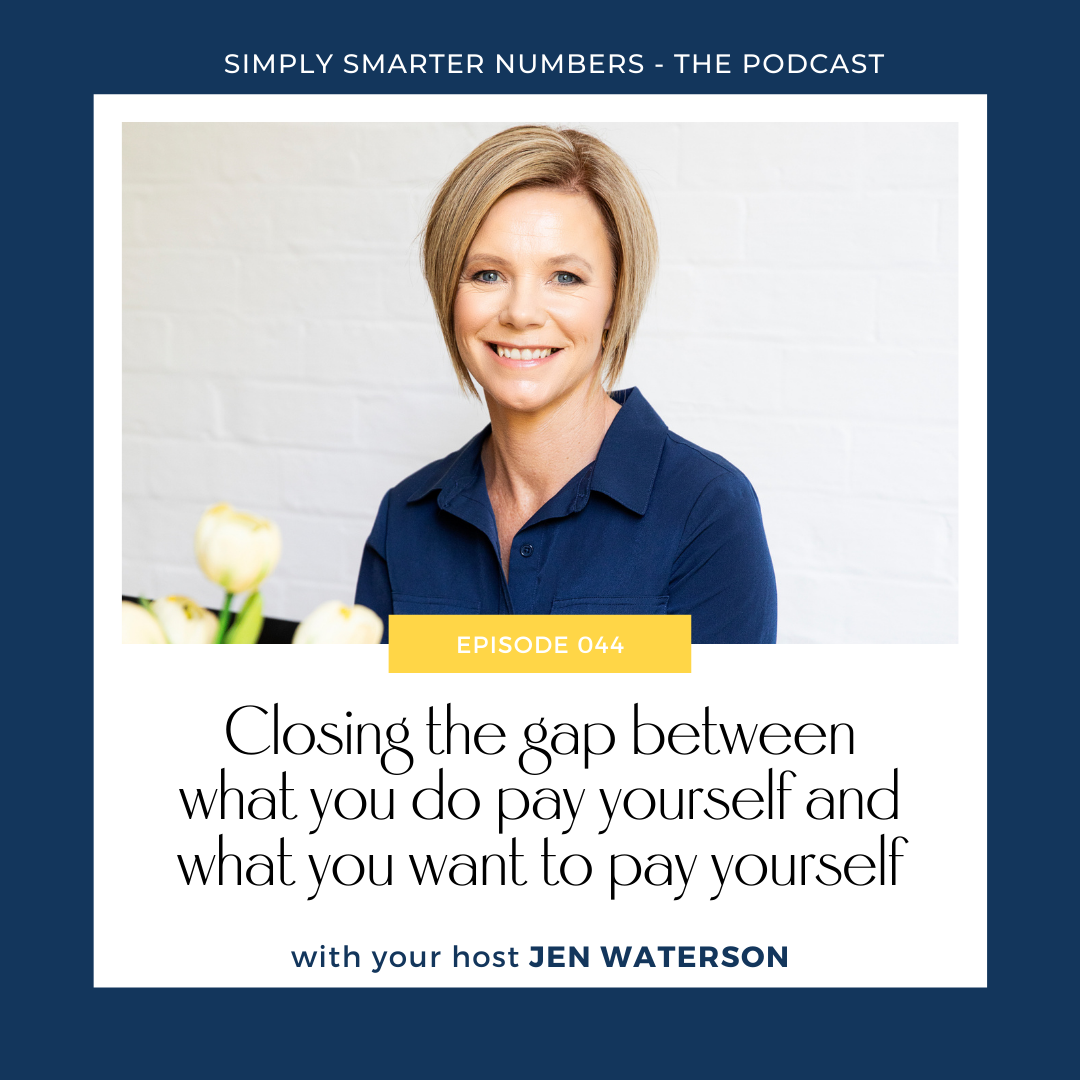
Here’s what we’ll cover
Let’s talk about the gap between what you pay yourself now and what you want to pay yourself.
How much are you paying yourself? How much do you want to pay yourself? How much should you be paying yourself? If there’s a gap between what you are paying yourself and what you want to pay yourself then listen in because I’m talking about why that gap might exist in the first place then I’m talking through what you might do to close that gap.
Links and Resources
- Checkout the Simply Smarter Numbers website HERE
- Checkout the Podcast HERE
- Checkout the Instagram page HERE
Keep Listening!
Here’s the shownotes
How much do you want to pay yourself – you, the owner of your business. Something that I posted about on instagram recently (by the way if we aren’t friends on instagram) get over there and let’s follow each other! You’ll find me at Simply Smarter Numbers. So something that I posted recently on instagram caught the attention of quite a few of you it seems. And it was all about identifying and closing the ‘gap’ between what you are paying yourself and what you want to be paying yourself.
So, I wanted to dive a little deeper into that topic today. We are going to cover these few questions;
What you want to pay yourself;
How much should you be paying yourself;
Why that gap might exist; and
What you can do to close that gap
But, before I do, everything I talk about in this podcast is expected to be general in nature and you should always, first and foremost consult your accountant about all the financial decisions you make in your business. Everyone’s particular situation is different and you all need to seek your own personal advice.
SO first up, your first job is to take a pen and write down what you are paying yourself right now. Right now, post the covid government handouts that nearly every business in Australia got. Right now, what are you paying yourself? Write it down. If your mind works better by looking at it as a weekly payment then fine what are you now taking out of your business for you each week. If your mind works better when you look at it annually then write down your number. If you are taking nothing – then write down zero.
Next, you’re going to consider how much you want to pay yourself. Want, not should, not might, not could pay yourself, how much do you want to pay yourself in an ideal world?
Here is a little task for you to do when you’re thinking about what you want to be able to pay yourself. Get together with your partner if you have one, pour yourselves a nice glass of wine and work through your ideal living budget, item by item. Ideal mortgage repayments, ideal car repayments, how much would you love to invest regularly, ideal entertainment budget, ideal holiday budget, ideal budget for memberships, school fees, clothing, – the works. List it all out one item at a time and put your ideal spend against each of them.
Let’s say that totals up to $180,000 your partner might be already contributing $80k of that so you want to have access to $100k – ideally.
Now this $100k needs to be after tax so you might need to add on some money for tax and depending on your situation let’s say for the sake of this story we are adding on another $30k for tax so I ideally want to be paying myself $130,000. I don’t know what your tax rate is or your business structure and before you ask me, there is no set amount you should take into account for tax because all of our situations are different.
So, right now you know what you are paying yourself now. Lets just say it’s $1000 per week so you’re paying yourself $52,000.
You also know what you want (not would, could, should) pay yourself and in the case of the little example above let’s say you want to pay yourself $130,000.
Now before I go on, I’m not going to talk about the way you pay yourself such as whether it’s a wage or drawings or whatever. That’s between you and your accountant and if you aren’t sure what you should be doing – talk to your accountant!
So the ‘gap’ in what you’re business is paying you in this example is $52,000 less $130,000 equals $78,000. Your $78k short on what you’d love to be taking out of the business.
$78k is the gap.
Before I talk about why that gap might exist I’ve been asked – how much ‘should’ I be paying myself.
My first answer is, ask your accountant.
My second answer is, it’s your business, you’re in charge, you decide.
My third answer is it could be really helpful to think about what you may have to pay someone else to do what you do.
Let’s talk for a moment about why that gap might be there;
You might be reinvesting all available funds back into growing the business.
You might be conservative when it comes to cash flow and you’d prefer to leave it in the business for any potential opportunities that might come up, a cash buffer in case of a downturn in your industry or in case you lose a big client that you’re too reliant on.
You might not be profitable enough.
You might have too much debt in the business and you need to smash that first before you can take anymore for yourself.
You’ve never asked your accountant if you can take some of the excess cash out for yourself.
Your business structure could include a business partner or an investor and that may present difficulties when it comes to paying yourself more.
Maybe you have too many jobs unfinished and too many accounts outstanding.
These are just a few broad reasons why the gap might be there.
Now I want to give you a few things you can look at now to work on closing that gap.
What you are selling – Your Service Offer;
Do you need to streamline your services, find out what’s profitable, what’s not profitable, stop selling some services, start to focus on others?
Stand back and review your service offer.
Is your current service offer ever going to be capable of making you the money you want? (without having to run yourself into the ground and work even more hours).
How are you pricing your services?
Get some no-fluff advice from someone outside of your business.
Are you selling the value in what you provide? Are you selling the benefits or the features, are you selling the health transformation or the number of exercise classes.
Is your pricing aligned with the value you think you provide? Are you too cheap or too expensive?
Does your branding, words, marketing, image reflect top class if you are providing a top class service with top class results and a top class price? If you’re not 100% certain, ask someone you can trust for an honest opinion (not a ‘yes’ person).
Do you need to tidy-up your efficiencies? What can you do better that will save you time and or money?
Are their holes in your team? Are they making you money or costing you money? How are you tracking this? What are you doing to make more from your team to get more from your team? What are you doing to help your team be the best, most productive, most profitable version of themselves?
So when it comes to working on closing the gap, use the ‘eyes-wide open’ approach and start with your service offering, your pricing, your efficiencies and your team.
If it’s time to take care of you and pay you a little more hopefully this will get you started!



